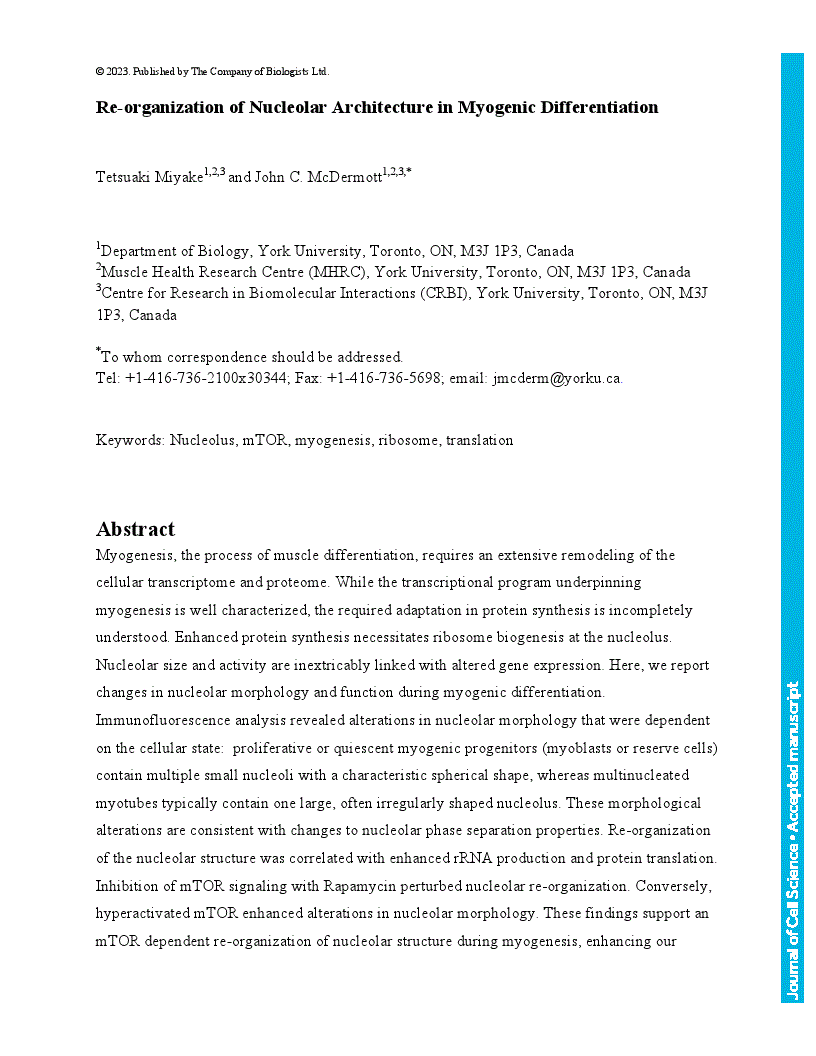Myogenesis, the process of muscle differentiation, requires an extensive remodeling of the cellular transcriptome and proteome. While the transcriptional program underpinning myogenesis is well characterized, the required adaptation in protein synthesis is incompletely understood. Enhanced protein synthesis necessitates ribosome biogenesis at the nucleolus. Nucleolar size and activity are inextricably linked with altered gene expression. Here, we report changes in nucleolar morphology and function during myogenic differentiation. Immunofluorescence analysis revealed alterations in nucleolar morphology that were dependent on the cellular state: proliferative or quiescent myogenic progenitors (myoblasts or reserve cells) contain multiple small nucleoli with a characteristic spherical shape, whereas multinucleated myotubes typically contain one large, often irregularly shaped nucleolus. These morphological alterations are consistent with changes to nucleolar phase separation properties. Re-organization of the nucleolar structure was correlated with enhanced rRNA production and protein translation. Inhibition of mTOR signaling with Rapamycin perturbed nucleolar re-organization. Conversely, hyperactivated mTOR enhanced alterations in nucleolar morphology. These findings support an mTOR dependent re-organization of nucleolar structure during myogenesis, enhancing our understanding of myogenesis and possibly facilitating new approaches to therapeutic interventions in muscle pathologies.
Re-organization of nucleolar architecture in myogenic differentiation

- Award Group:
- Funder(s): Natural Sciences and Engineering Research Council of Canada
- Award Id(s): RGPIN-2018-05898
- Funder(s):
- Award Group:
- Funder(s): Canadian Institutes of Health Research
- Award Id(s): PJT-159644
- Funder(s):
Currently Viewing Accepted Manuscript - Newer Version Available
- Split-screen
- Views Icon Views
- Open the PDF for in another window
-
Article Versions Icon
Versions
- Version of Record 21 February 2023
- Accepted Manuscript 02 February 2023
- Share Icon Share
-
Tools Icon
Tools
- Search Site
Tetsuaki Miyake, John C. McDermott; Re-organization of nucleolar architecture in myogenic differentiation. J Cell Sci 2023; jcs.260496. doi: https://doi.org/10.1242/jcs.260496
Download citation file:
Advertisement
Introducing our new Editors

We welcome three new Editors to Journal of Cell Science - Robert Parton, Richa Rikhy and Simon Cook. You can read more about them in the Editorial from our Editor-in-Chief Michael Way.
2024 Journal Meeting 'Diversity and Evolution in Cell Biology'

Registration is open for our 2024 Journal Meeting Diversity and Evolution in Cell Biology, which aims to bring together evolutionary biologists and cell biologists investigating diverse aspects of cellular physiology. Final registration deadline: 3 May 2024.
Workshop: Physics of the Early Embryonic Cell Divisions

Early-career researchers interested in the roles of nuclear lipids, apply now for one of the ten funded places at this Workshop, which will take place 11-14 November 2024. Application deadline: 17 May.
Reasons to submit to Journal of Cell Science

There are many benefits to publishing in Journal of Cell Science - read more about why you should choose JCS or visit our submission page now.
Propose a new Workshop for 2026

We are now accepting proposals for our 2026 Workshops programme. We aim to be responsive to the community and open to novel initiatives, so if you have a new idea for a biological workshop that you feel would work well, please apply. Applications deadline: 19 July 2024.



